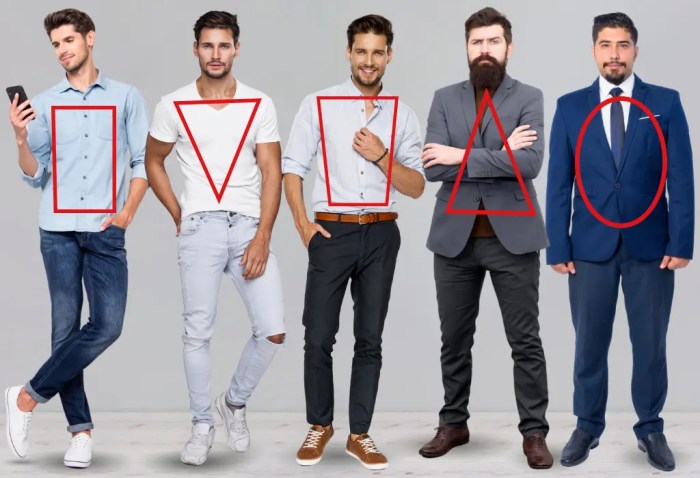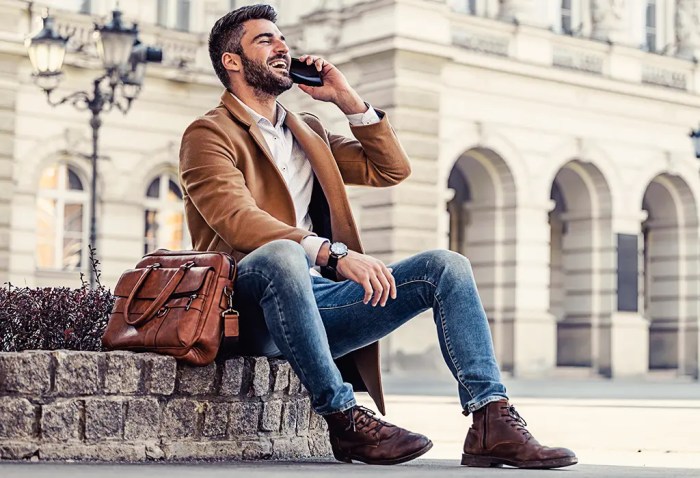Help with Mens Fashion A Style Guide
Understanding Men’s Fashion Basics

Source: realmenrealstyle.com
Help with men’s fashion – Mastering men’s fashion begins with understanding fundamental principles. This involves grasping the interplay of fit, silhouette, and proportion, choosing appropriate clothing sizes for your body type, and building a versatile capsule wardrobe. This section will delve into these core elements, equipping you with the knowledge to build a solid foundation for your personal style.
Fit, Silhouette, and Proportion
Proper fit is paramount. Clothes that fit well enhance your physique, while ill-fitting clothes can detract from your overall appearance. A good fit considers the length of sleeves and trousers, the width of shoulders and chest, and the overall drape of the garment. Silhouette refers to the overall shape created by your clothing; it can be slim, relaxed, or tailored.
Proportion involves balancing the different elements of your outfit, ensuring no single piece overwhelms the others. For example, a larger man might benefit from a longer jacket to balance his proportions.
Choosing the Right Clothing Sizes
Clothing sizes vary significantly between brands and styles. Understanding your body measurements (chest, waist, inseam, etc.) is crucial. Don’t solely rely on numerical sizes; always try clothes on to assess the fit. Consider your body type – athletic, slim, or larger – when choosing sizes. A slim-fit shirt might not suit a larger build, while a relaxed-fit shirt might overwhelm a slimmer frame.
Creating a Versatile Capsule Wardrobe

Source: realmenrealstyle.com
A capsule wardrobe consists of a small collection of versatile, high-quality items that can be mixed and matched to create numerous outfits. Focus on neutral colors (navy, gray, black, white) as a base, and incorporate a few accent colors to add personality. Include essential pieces like well-fitting jeans, chinos, a blazer, a few versatile shirts, and comfortable shoes.
This approach maximizes your wardrobe’s potential and minimizes decision fatigue.
Fabric Comparison
| Fabric | Properties | Suitable Seasons | Care Instructions |
|---|---|---|---|
| Cotton | Breathable, absorbent, comfortable | Spring, Summer | Machine washable |
| Linen | Breathable, absorbent, wrinkle-prone | Spring, Summer | Machine washable, often requires ironing |
| Wool | Warm, insulating, durable | Autumn, Winter | Dry clean or hand wash |
| Silk | Luxurious, smooth, delicate | Spring, Summer, Autumn | Dry clean |
Building a Stylish Wardrobe
Constructing a functional and fashionable wardrobe doesn’t require a vast budget. This section details a step-by-step approach to building your wardrobe strategically, focusing on essential items and the art of accessorizing to elevate your style.
Building a Wardrobe on a Budget
- Assess your needs: Identify gaps in your current wardrobe.
- Prioritize essentials: Focus on high-quality basics before investing in trendier pieces.
- Shop strategically: Look for sales, discounts, and consider secondhand options.
- Invest in versatile items: Choose pieces that can be mixed and matched.
- Care for your clothes: Proper care extends the life of your garments.
The Importance of Accessorizing
Accessories can significantly elevate an outfit. A well-chosen watch, belt, or scarf can add personality and sophistication. Examples of versatile accessories include leather belts, simple watches, pocket squares, and scarves in neutral colors.
Casual, Smart Casual, and Formal Attire
Understanding the distinctions between these dress codes is essential. Casual attire is relaxed and comfortable; smart casual blends casual and formal elements; formal attire is highly structured and traditional. Knowing the appropriate dress code for different occasions ensures you present yourself appropriately.
Essential Wardrobe Items
A modern man’s wardrobe should include a range of items suitable for various occasions. This includes tailored suits for formal events, casual pieces like jeans and t-shirts for everyday wear, and versatile options like chinos and blazers for smart casual occasions.
Mastering Different Styles
Men’s fashion encompasses a wide range of styles, each with its own distinct characteristics. This section explores several popular styles, offering insights into their defining features and demonstrating how to incorporate personal touches to create a unique look.
Classic, Minimalist, Modern, and Preppy Styles
The classic style emphasizes timeless pieces and clean lines. Minimalist style prioritizes simplicity and functionality. Modern style incorporates contemporary trends and silhouettes. Preppy style draws inspiration from Ivy League aesthetics. Each style offers a distinct aesthetic, allowing for individual expression.
Incorporating Personal Style
Personal style is about expressing your individuality through clothing. Experiment with different styles and find what resonates with you. Don’t be afraid to mix and match elements from different styles to create a look that reflects your personality.
Mixing and Matching Outfits, Help with men’s fashion
The ability to mix and match clothing items is key to building a versatile wardrobe. Experiment with different color combinations, textures, and patterns. Start with simple combinations and gradually build complexity as you gain confidence.
Shopping and Maintaining Clothes: Help With Men’s Fashion
This section provides guidance on effective clothing shopping, both online and in-store, emphasizing quality and value. It also offers practical tips on caring for different clothing materials to maximize their lifespan and maintain their appearance.
Effective Shopping Strategies
When shopping, prioritize quality over quantity. Examine the construction of garments, looking for details like stitching quality and fabric weight. Read reviews and compare prices before purchasing. Online shopping offers convenience, but be sure to check return policies and sizing charts carefully.
Caring for Different Clothing Materials
Proper care is essential for extending the life of your clothes. Follow care instructions carefully, and consider professional cleaning for delicate fabrics. Regularly inspect your garments for damage and address any issues promptly.
Identifying Quality Garments
Well-made clothing exhibits superior construction, durable materials, and attention to detail. Look for even stitching, reinforced seams, and high-quality zippers and buttons. Compare similar items from different brands to assess the differences in quality.
Clothing Maintenance Tasks
| Task | Method |
|---|---|
| Washing | Follow care instructions; use appropriate detergents and water temperature. |
| Ironing | Use the appropriate heat setting for the fabric type. |
| Dry Cleaning | Use a reputable dry cleaner for delicate fabrics. |
| Storage | Store clothes properly to prevent wrinkles and damage. |
Personal Style Development
Developing a strong personal style involves understanding your body shape, utilizing color theory effectively, and considering the impact of grooming and hairstyles. This section provides guidance on these crucial aspects of personal style development.
Understanding Body Shape
Your body shape influences which clothing styles and silhouettes will flatter you most. Understanding your body type (e.g., athletic, ectomorph, mesomorph, endomorph) allows you to choose clothes that accentuate your assets and minimize any perceived flaws.
Color Theory in Men’s Fashion
Color theory plays a significant role in how you appear. Understanding color palettes and how colors interact can help you choose outfits that flatter your complexion and enhance your overall look. Consider your skin tone when selecting colors; warmer skin tones generally suit warmer colors, while cooler skin tones often look better in cooler colors.
Hairstyle and Grooming
A well-chosen hairstyle and grooming routine significantly impact your overall appearance. Consider your face shape and hair type when choosing a hairstyle. Maintaining a clean and well-groomed appearance contributes to a polished look. For example, a well-maintained beard can add a touch of sophistication, while a neatly trimmed haircut can create a more youthful look.
Navigating the world of men’s fashion can sometimes feel overwhelming. Finding the right pieces to build a versatile wardrobe requires careful consideration. A great starting point is exploring options like mens fashion long sleeve shirts, which offer both style and practicality. Ultimately, developing your personal style involves experimentation and understanding what works best for your body type and lifestyle.
Finding Inspiration and Building Confidence
Find inspiration from various sources, including magazines, blogs, social media, and even observing people whose style you admire. Experiment with different looks and gradually build your confidence. Remember that personal style is a journey, not a destination.
Addressing Specific Fashion Challenges
This section offers strategies for men who lack fashion confidence or face common style issues, emphasizing the importance of fit, tailoring, and incorporating trends thoughtfully.
Strategies for Building Fashion Confidence
Start small. Focus on mastering the basics before venturing into more complex styles. Seek advice from friends, stylists, or online resources. Remember that fashion is about self-expression, not perfection.
Solutions for Common Style Issues
Ill-fitting clothes can be altered by a tailor. Outdated garments can be updated with simple accessories or by incorporating them into more modern outfits. Experimentation and a willingness to learn are key to overcoming these challenges.
The Importance of Fit and Tailoring
Proper fit is essential for a polished look. Tailoring can significantly improve the fit and appearance of your clothes, making them look more expensive and sophisticated.
Incorporating Current Trends Thoughtfully
Don’t feel pressured to follow every trend. Instead, choose elements that align with your personal style and complement your existing wardrobe. Incorporate trends subtly, rather than adopting an entire look at once.
Questions Often Asked
What are some common mistakes men make in choosing clothes?
Ignoring proper fit, neglecting accessories, and choosing clothes that don’t suit their body type or personality are common mistakes.
How can I find my personal style?
Experiment with different styles, identify what makes you feel confident and comfortable, and draw inspiration from various sources. Consider your lifestyle and personality.
Where can I find affordable, high-quality clothing?
Look for sales, shop at outlet stores, consider investing in fewer high-quality pieces rather than many cheap ones, and explore sustainable and ethical brands.
How often should I update my wardrobe?
There’s no set timeframe. Update as needed based on wear and tear, changes in style preferences, or when you need clothing for new occasions.





















